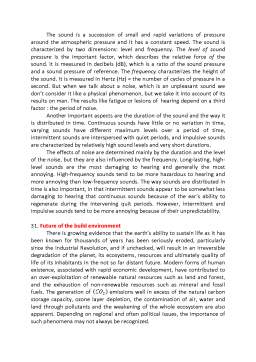Extras din notiță
1.Natural resource*
A natural resource is usually defined as anything obtained from the physical environmental to meet human needs. Some resources are available for use directly from the environment. Examples include solar energy, fresh air, rainwater, fresh water in a river or stream and naturally growing edible plants.
Other resources depend on a combination of human ingenuity, economics and cultural beliefs.
Human ingenuity enables us to develop scientific and technological methods for finding, extracting and processing many of the earth's natural substances and converting them to usable forms.
Ground water found deep below the earth's surface was not a resource until we developed the technology for drilling and installing pumps to bring it to the surface. Petroleum was a mysterious fluid until humans learnt how to locate it, extract it and refine it into gasoline and other products.
Economics also determines whether something is classified as a resource or a potential resource. Some known deposits of oil, coal, copper and other potentially useful materials are located so far beneath the earth's surface or in such low concentrations that they would cost more to find, extract, and process than they are worth.
2.Classification of resources
Resources can be classified as nonrenewable, renewable and perpetual.
A nonrenewable resource is one that exists in a fixed amount in various places in the earth's crust and either is not replenished by natural processes or is replenished more slowly than it is used.
Examples:
- fossil fuels - buried deposits of decayed plants and animals that have been converted to materials such as oil, coal and natural gas by heat and pressure in the earth's crust over hundreds of millions of years;
- metallic minerals such as uranium, iron and aluminum;
- nonmetallic minerals such as phosphates and potassium used as plant nutrients in commercial fertilizers.
A nonrenewable resource such as oil or copper is considered depleted from an economic standpoint when 80% of its total estimated supply has been removed and used.
Some non-renewable resources can be recycled or reused to stretch supplies – cooper, aluminum, iron and glass, for example – and others, such as fossil fuels, cannot. Recycling involves collecting and remelting or reprocessing a resource (aluminum beverage cans), whereas reuse involves using a resource over and over in the same form (refillable bottles). But discarded aluminum cans, refillable bottles and abandoned cars can be widely that it becomes too costly to collect them for reuse or recycling.
A renewable resource is one that can be depleted in the short run if used or contaminated too rapidly but normally will be replaced through natural processes in the long run. Examples: trees in forests, grass in grasslands, fish and game, fresh surface water in lakes and rivers, most deposits of ground water, fresh air and fertile soil.
Classifying something as a renewable resource, however does not mean that is inexhaustible and that it will always remain renewable. The highest rate at which a renewable resource can be used without impairing or damaging its ability to be fully renewed is called its sustained yield. If his yield is exceeded the base supply of a renewable resource begins to shrink and can become nonrenewable on a human time scale or in some cases nonexistent – a process known as environmental degradation.
A perpetual resource is one that comes from an essentially inexhaustible source and thus will always be available in a relatively constant supply regardless of whether or how it is used. Solar energy is the most important example of such a resource.
3.Pollution
Any change in the physical, chemical or biological characteristics of the air, water or soil that can affect the health, survival or activities of human or other forms of life in an undesirable way is called pollution. Pollution does not have to cause physical harm; pollutants as noise and heat cause injury but more often cause psychological distress and aesthetic pollution such as foul odours and unpleasant sights offend the senses.
4.Types, sources and effects of pollutants
As long as they are not overloaded, natural processes or human-engineered systems (such as sewage treatment plants) can biodegrade or break down some types of pollutants to an acceptable level or form. Depending on their biodegradability, pollutants can be classified as being rapidly biodegradable (such as sewage and livestock wastes), slowly biodegradable (such as DDT and other chemical pesticides) and nonbiodegradable (such as toxic mercury and lead compounds and some radioactive substances)
Polluting substances can enter the environment naturally or through human activities. Most natural pollution is dispersed over a large area and is often diluted or degraded to harmless levels by natural processes. In contrast, the most serious human pollution problems occur in or near urban and industrial areas, where large amounts of pollutants are concentrated in relatively small volumes of air, water and soil. Furthermore, many pollutants from human activities are synthetic (human made) chemicals that are slowly biodegradable or nonbiodegradable.
Often, pollutants released into one part of the environment do not remain there and can affect people and other forms of life at the local, regional and in some cases the global levels.
Pollutants can have both acute and chronic effects on human health. An acute effect, such as a burn, illness or death, occurs shortly after exposure, often in response to fairly high concentrations of a pollutant. A chronic effect is a condition that lasts a long time and usually takes long time to appear, often due the exposure to low concentrations of a pollutant. For example, people exposed to a large dose of radiation may die in a few days. However, people recurring the same total dose in a small amounts over a long period of time may develop various types of cancer 10 to 20 years later or may transmit genetic defects to their children.
Preview document
Conținut arhivă zip
- Ingineria Mediului.doc

































